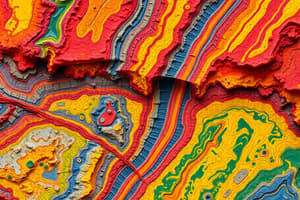Podcast
Questions and Answers
¿¿¿¿?
¿¿¿¿?
- ¿¿¿ (correct)
- ¿¿¿ (correct)
- ¿¿¿ (correct)
- ¿¿¿ (correct)
- (correct)
- (correct)
- (correct)
- (correct)
¿¿¿¿¿¿¿¿?
¿¿¿¿¿¿¿¿?
- ¿¿¿¿ (correct)
- ¿¿¿¿ (correct)
- ¿¿¿¿ (correct)
- ¿¿¿¿ (correct)
¿¿¿¿¿¿¿¿?
¿¿¿¿¿¿¿¿?
Flashcards are hidden until you start studying
Study Notes
Mountain Formation
- Types of Mountain Formation:
- Volcanic: formed by volcanic activity, e.g., shield volcanoes
- Fold: formed by folding of Earth's crust, e.g., Himalayas
- Block: formed by faulting, e.g., Sierra Nevada
- Mountain Building Processes:
- Plate convergence: collision of tectonic plates
- Uplift: vertical movement of Earth's surface
- Volcanic activity: eruption of magma and lava
Volcanic Landforms
- Types of Volcanic Landforms:
- Shield volcanoes: gently sloping, broad volcanoes
- Stratovolcanoes: tall, conical volcanoes
- Calderas: large depressions formed by volcanic collapse
- Volcanic Features:
- Craters: depressions at the volcano's summit
- Lava flows: streams of molten rock
- Volcanic ash: fine particles ejected during eruptions
Desert Landscapes
- Desert Features:
- Dunes: ridges of sand formed by wind
- Oases: isolated areas of vegetation in deserts
- Playas: dry lake beds
- Desert Formation Processes:
- Wind erosion: removal of rock and soil by wind
- Deflation: removal of loose sediment by wind
- Deposition: accumulation of sediment in a new location
Plate Tectonics
- Theory of Plate Tectonics:
- Earth's lithosphere is divided into large plates
- Plates move relative to each other, creating and destroying landforms
- Plate Boundaries:
- Divergent: plates moving apart, e.g., mid-ocean ridges
- Convergent: plates moving together, e.g., subduction zones
- Transform: plates sliding past each other, e.g., fault lines
Coastal Features
- Types of Coastal Features:
- Headlands: rocky areas that jut out into the sea
- Bays: areas of coastline indented by the sea
- Deltas: areas of sediment deposited at a river mouth
- Coastal Processes:
- Erosion: removal of rock and soil by the sea
- Deposition: accumulation of sediment along the coast
- Longshore drift: movement of sediment along the coast by currents
Studying That Suits You
Use AI to generate personalized quizzes and flashcards to suit your learning preferences.




